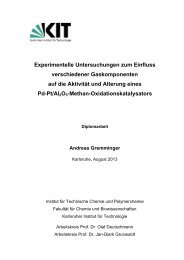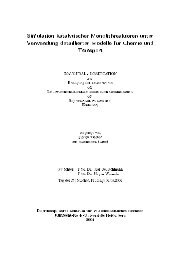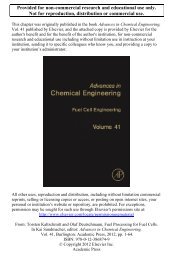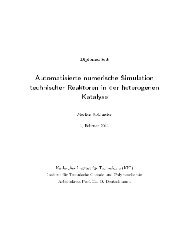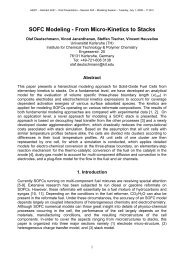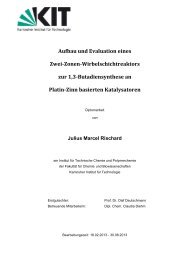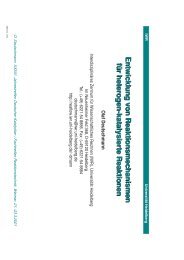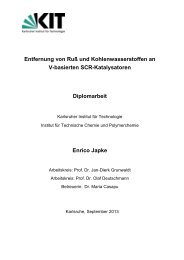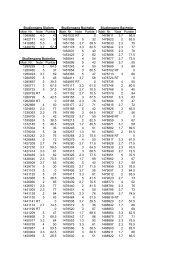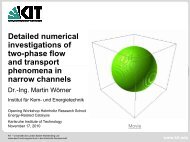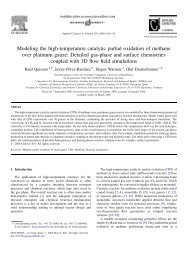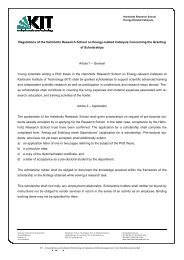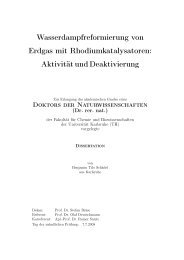Tutorial Modeling of monolith reactors
Tutorial Modeling of monolith reactors
Tutorial Modeling of monolith reactors
You also want an ePaper? Increase the reach of your titles
YUMPU automatically turns print PDFs into web optimized ePapers that Google loves.
Introduction to Monolith<br />
Reactor Modelling:<br />
Mass, Energy and Momentum Transport<br />
R.E. Hayes<br />
Department <strong>of</strong> Chemical and Materials<br />
Engineering, University <strong>of</strong> Alberta,<br />
Edmonton, Alberta, Canada<br />
MODEGAT 14-15 September 2009<br />
1
Objectives <strong>of</strong> this presentation<br />
• To give an introductory overview to the<br />
area <strong>of</strong> <strong>monolith</strong> reactor modelling<br />
• To high light some <strong>of</strong> the factors that<br />
must be taken into consideration when<br />
choosing a model.<br />
2
Why use computer modelling?<br />
• Experiments are expensive and take time.<br />
• Analysis <strong>of</strong> <strong>reactors</strong> can be difficult, especially for<br />
fast highly exothermic reactions. Non-intrusive<br />
measurement methods may not be available.<br />
• Modelling can eliminate scenarios that do not<br />
<strong>of</strong>fer promise.<br />
• Faster design and optimisation.<br />
Models are not intended to eliminate experiments completely.<br />
3
Typical catalytic converter<br />
•The The catalytic converter uses a metal or ceramic <strong>monolith</strong><br />
support structure.<br />
•Typical Typical automotive converters use 400 CPSI cell density<br />
Hayes and Kolaczkowski, Chem.<br />
Eng. Sci., 49, 3587, 1994.<br />
Heck and Farrauto, Catalytic Air<br />
Pollution Control, 2002<br />
4
Observations<br />
• The problem involves the transport <strong>of</strong> mass, energy<br />
and momentum. It is a multi-physics<br />
problem.<br />
• Transport occurs at different scales in space.<br />
• The transient response <strong>of</strong> the gas phase and solid<br />
phase occurs at different time scales.<br />
• Modelling <strong>of</strong> <strong>monolith</strong> <strong>reactors</strong> is thus an exercise in<br />
multi-scale modelling.<br />
The <strong>monolith</strong> reactor presents a challenging modelling problem.<br />
5
Heterogeneous catalytic reactions<br />
Heterogeneous gas phase catalytic reactions typically comprise the same steps.<br />
Fluid flow over the solid results in a<br />
boundary layer through which heat and<br />
mass diffuse to the gas/solid interface.<br />
Reactants diffuse into the porous<br />
catalyst.<br />
External<br />
catalyst<br />
surface<br />
catalyst<br />
pore<br />
Bulk gas<br />
Reactants adsorb on the active sites.<br />
The reaction occurs on the active sites,<br />
located on the walls <strong>of</strong> the tortuous pores.<br />
Products desorb and diffuse back to the<br />
surface, and then through the boundary<br />
layer to the bulk fluid.<br />
6
Model Scales<br />
Micro scale: At the atomic/molecular level, the basic chemistry<br />
involves a set <strong>of</strong> adsorption/desorption and surface reaction<br />
steps. The genuine mechanism may be very complicated.<br />
Gas Phase<br />
Catalyst<br />
Meso scale: Single channel <strong>of</strong> a <strong>monolith</strong>. Includes gas<br />
phase flow, transport to the surface <strong>of</strong> the washcoat by<br />
diffusion, diffusion and reaction in the washcoat. The<br />
basic process in a heterogeneous catalytic reaction are<br />
present at the meso scale.<br />
Macro scale: Entire catalytic converter, which<br />
includes transport and interaction among channels.<br />
7
Model complexity: Points to note<br />
• How much complexity is wanted and or needed?<br />
– At what level do you wish to model?<br />
– How much information do you want to include?<br />
– Do you need to include all <strong>of</strong> the scales?<br />
• The model should be as simple as possible, but not<br />
simpler (Albert Einstein).<br />
• Models do not have to be perfect to be useful.<br />
Gas Phase<br />
Catalyst<br />
8
Mathematical formulation<br />
• The fundamental model is represented by a set <strong>of</strong><br />
equations, which include key assumptions<br />
– Algebraic equations, linear or non-linear<br />
– Ordinary differential equations (IVP or BVP)<br />
– Partial differential equations<br />
• Practical <strong>monolith</strong> modelling problems do not have<br />
analytical solutions; models are solved numerically.<br />
• The model selected and the way it is represented will<br />
determine the numerical method used for its solution.<br />
9
Mathematical formulation<br />
• Reactors are fundamentally distributed parameter<br />
systems ; Concentration, temperature and velocity<br />
vary with spatial coordinate.<br />
• The dimensionality (and hence complexity) can be<br />
reduced by using average parameter values over<br />
specified model dimensions. The result is referred<br />
to as a lumped parameter model.<br />
• Lumped parameter models are approximations.<br />
10
Basic models in common use<br />
• Single channel <strong>of</strong> <strong>monolith</strong> structure<br />
– 1D, 2D or 3D<br />
– Diffusion in the washcoat may be considered<br />
• Whole reactor with variable channel conditions<br />
and channel interactions<br />
– 2D or 3D , several model options exist<br />
– The upstream and downstream duct work might<br />
be included<br />
11
Single channel model (SCM)<br />
• Single channel <strong>of</strong> <strong>monolith</strong> structure<br />
• For a radially uniform <strong>monolith</strong>, the SCM is<br />
representative <strong>of</strong> the whole reactor<br />
• There are many approaches to writing a single<br />
channel model:<br />
– PDE models (all 2D and 3D models, some 1D)<br />
– ODE models (some 1D models)<br />
– Algebraic equations only (some 1D models)<br />
12
The 3D SCM<br />
• The real <strong>monolith</strong> does not have<br />
axial symmetry.<br />
• The washcoat can have a variety<br />
<strong>of</strong> possible shapes.<br />
• 3D is required for exact channel<br />
representation<br />
13
The 3D SCM<br />
• A minimum <strong>of</strong> a one-eighth<br />
section must be considered.<br />
• For complex shapes such as the<br />
“sinusoidal” channel, the entire<br />
cross section must be<br />
considered.<br />
• There is no analytical solution<br />
for the velocity.<br />
• Must solve the transport<br />
equations in three dimensions.<br />
14
The 2D approximate SCM<br />
• The 2D model approximates the<br />
channel as a right circular cylinder<br />
with a uniform annular washcoat<br />
layer, thus giving axi-symmetry.<br />
• The flow area, washcoat area and<br />
substrate area should be the same<br />
for each system.<br />
• The 2D model is still the most<br />
complex model that is used<br />
routinely.<br />
• The fully developed flow field can<br />
be approximated, thus reducing the<br />
number <strong>of</strong> equations to solve.<br />
15
2D and 3D SCM<br />
• 2D and 3D SCM are both distributed parameter<br />
models.<br />
• Temperature, concentrations and velocities vary with<br />
both axial (flow direction) and radial (transverse to<br />
flow) directions.<br />
• The most general model requires the solution <strong>of</strong> a set<br />
<strong>of</strong> coupled non-linear partial differential equations.<br />
• The equations are the same in each case – only the<br />
number <strong>of</strong> space dimensions changes.<br />
16
The 2D SCM<br />
• All <strong>of</strong> the physical/chemical processes present<br />
in 2D and 3D can be illustrated using a two<br />
dimensional model.<br />
Mass Transfer<br />
Direction <strong>of</strong> flow<br />
Heat Transfer<br />
Convection Radiation<br />
washcoat Diffusion and reaction Conduction<br />
substrate<br />
Conduction<br />
Centreline <strong>of</strong> wall<br />
17
Basic solution procedure<br />
• Each physical space (fluid, washcoat and substrate)<br />
is a computational domain governed by the<br />
conservation equations.<br />
• Write the governing differential equations for each<br />
domain (fluid, washcoat and substrate)<br />
• Often only the solid state energy balance equations<br />
retain the transient terms, owing to the relative<br />
magnitude <strong>of</strong> the time scales for fluid and solid.<br />
18
Modelling the fluid domain<br />
Velocity and pressure are obtained from the Navier-Stokes equation<br />
and the equation <strong>of</strong> continuity:<br />
⎡<br />
( ) (<br />
T<br />
( ) )<br />
⎛2η<br />
⎞ ⎤<br />
ρ vi∇ v = ∇i⎢− pI + η ∇ v + ∇v − ⎜ −κ ( ∇ v)<br />
I<br />
3<br />
⎟ i ⎥<br />
⎣<br />
⎝ ⎠ ⎦<br />
( v) 0<br />
∇i<br />
ρ =<br />
The density depends on temperature.<br />
The mass balance (assuming Fick’s law) is:<br />
( D w ) v ( w ) 0<br />
∇⋅ ρ ∇ − ρ⋅∇ =<br />
A A A<br />
The energy balance is:<br />
( k T) ( C ) vi<br />
T 0<br />
∇i<br />
∇ − ρ ∇ =<br />
f p f<br />
Species conservation should be<br />
expressed in terms <strong>of</strong> the mass<br />
fraction because mass is conserved.<br />
19
Observations<br />
• The fluid equations are very classical and can be<br />
readily solved.<br />
• The mass and energy balances are coupled to the<br />
washcoat at the gas solid interface.<br />
• A zero slip condition is usually imposed at the gas<br />
solid interface and a zero velocity boundary<br />
condition imposed.<br />
• One mass balance equation needed for each<br />
species.<br />
20
Modelling the washcoat domain<br />
• The washcoat is a porous matrix containing solid<br />
and fluid fractions.<br />
• The diffusion/reaction occurs in the fluid fraction,<br />
which is comprised <strong>of</strong> a network <strong>of</strong> tortuous pores.<br />
• It is too complicated to model the actual diffusion<br />
in the porous network (and the structure is<br />
unknown in any case)<br />
• Diffusion is thus assumed to occur across the entire<br />
matrix and is governed by an effective diffusion<br />
coefficient, with a Fickian type <strong>of</strong> approach.<br />
21
Washcoat balance equations:<br />
The mass balance equations are solved for the washcoat:<br />
( )<br />
∇⋅ ( D ) ρ ∇w − ( − R ) = 0<br />
eff A A A<br />
One mass balance for each species<br />
The energy balance is:<br />
∂T<br />
R p S<br />
( k ) ( ) ( )<br />
eff T H ( RA<br />
) C<br />
∇i<br />
∇ + −Δ − = ρ<br />
∂t<br />
Normally the momentum balance equation is not solved in the washcoat.<br />
22
Diffusion in the washcoat<br />
• Diffusion in the pore is governed by a combination<br />
<strong>of</strong> bulk diffusion (molecular collisions) and Knudsen<br />
diffusion (collisions <strong>of</strong> molecules with the wall).<br />
• The relative importance <strong>of</strong> the two depends on the<br />
gas pressure and the pore size.<br />
• The effective diffusion coefficient is then computed<br />
by adjusting for catalyst porosity and tortuosity.<br />
• For a real catalyst with a given pore size<br />
distribution, the calculation <strong>of</strong> effective diffusion<br />
coefficients is not obvious.<br />
23
Diffusion in the washcoat<br />
• For binary eqi-molar counter diffusion <strong>of</strong> molecules<br />
A and B we write, for the diffusion <strong>of</strong> A:<br />
D<br />
0.5<br />
⎛ 1 1 ⎞<br />
0.01013⎜<br />
+<br />
M M<br />
⎟<br />
⎝ ⎠ T<br />
P<br />
A B<br />
AB =<br />
0.333 0.333<br />
(( ∑ ) ( ) )<br />
νi<br />
+ ∑νi<br />
A<br />
Bulk diffusion: Fuller correlation<br />
1 1 1<br />
= +<br />
( Dpore) D ( D )<br />
A<br />
AB<br />
Diffusion coefficient in the pore<br />
K<br />
B<br />
A<br />
1.75<br />
( D K ) A<br />
= 48.5 d p<br />
M A<br />
Knudsen diffusion<br />
( D ) = ( D pore )<br />
Effective diffusion coefficient<br />
in the washcoat<br />
T<br />
eff A A<br />
ε<br />
τ<br />
24
Modelling the substrate domain<br />
The energy balance is:<br />
∂ T<br />
eff p S<br />
( k T) ( C )<br />
∇i<br />
∇ = ρ<br />
∂ t<br />
The substrate is a porous medium and is modelled using effective properties.<br />
25
Remarks: 2D and 3D models<br />
• The basic equations are the same for 2D and 3D<br />
models.<br />
• Solution can be done using commercial or custom<br />
s<strong>of</strong>tware 3D models will take much longer to solve.<br />
• Normally, a finite element or finite volume method<br />
will be used.<br />
• For steady state models the substrate equations<br />
can be eliminated.<br />
26
Comparing 2D and 3D models<br />
• The channel reconfiguration can cause model<br />
differences.<br />
Increasing boundary<br />
temperature<br />
Reactant concentration at two temperatures in a washcoat fillet.<br />
27
Comparing 2D and 3D models<br />
Reactant concentration in a complex shape<br />
28
Comparing 2D and 3D models<br />
• The following light-<strong>of</strong>f simulations show some<br />
comparisons between 2D and 3D models.<br />
• 2D model uses a circular washcoat and a<br />
circular substrate (circle/circle)<br />
• 3D model 1 uses a circular washcoat in a<br />
square substrate (circle/square)<br />
• 3D model 2 uses a square washcoat in a<br />
square substrate (square/square).<br />
More et al., Topics in Catalysis, 37 155 (2006)<br />
29
Comparing 2D and 3D models<br />
100<br />
100<br />
80<br />
Circle/circle<br />
Circle/square<br />
Square/square<br />
80<br />
Circle/circle<br />
Circle/square<br />
Square/square<br />
Percentage Conversion<br />
60<br />
40<br />
Percentage Conversion<br />
60<br />
40<br />
20<br />
20<br />
0<br />
475 500 525 550<br />
Inlet Gas Temperature /K<br />
0<br />
475 500 525 550 575<br />
Inlet Gas Temperature /K<br />
Inlet temperature ramp rate <strong>of</strong> 30 K/min at a GHSV <strong>of</strong> 20 000 h -1 and 80 000 h -1 .<br />
More et al., Topics in Catalysis, 37 155 (2006)<br />
30
Comparing 2D and 3D models<br />
Percentage Conversion<br />
100<br />
80<br />
60<br />
40<br />
20<br />
Circle/circle<br />
Circle/square<br />
Square/square<br />
0<br />
500 520 540 560 580 600 620 640<br />
Inlet temperature / K<br />
Inlet temperature ramp rate <strong>of</strong> 300 K/min at a GHSV <strong>of</strong> 80 000 h -1 .<br />
More et al., Topics in Catalysis, 37 155 (2006)<br />
31
The 1D SCM approximation<br />
• 2D and 3D models can be time consuming to run<br />
and may not be necessary.<br />
• The radial dimension is eliminated using radial<br />
average properties. The model is transformed into a<br />
lumped parameter model in the radial direction.<br />
• Parameter lumping introduces a discontinuity at the<br />
gas solid interface which is handled using mass and<br />
heat transfer coefficients.<br />
• The washcoat and substrate are collapsed into a<br />
single one dimensional equation.<br />
32
Review <strong>of</strong> boundary layer flow<br />
Flow over a flat plate with exothermic<br />
U ∞<br />
reaction at the surface:<br />
δ<br />
Boundary layers develop for velocity,<br />
temperature and concentration.<br />
T ∞<br />
δ T<br />
T S<br />
C C∞ ∞<br />
C S<br />
U ∞<br />
T ∞<br />
δ C<br />
The boundary layer thickness increases with<br />
length<br />
The boundary layers have different thickness:<br />
δ n δ n δ<br />
= Sc = Pr<br />
T<br />
=<br />
δ δ δ<br />
C T C<br />
Sc<br />
Pr<br />
n<br />
n<br />
33
Thermal boundary layer<br />
T ∞<br />
T ∞<br />
T S<br />
δ T<br />
The heat transfer at the surface is :<br />
The heat transfer can be defined as:<br />
∂T<br />
q′′ = −k<br />
∂<br />
y<br />
y = 0<br />
( )<br />
′′ = −<br />
q h TS<br />
T ∞<br />
The heat transfer coefficient h assumes a value to make the equality true.<br />
If the temperature gradient at the surface is known, then h can be calculated.<br />
34
Boundary layers in a tube<br />
• At the entrance, boundary<br />
layers grow from the surface.<br />
• After the entry length, the<br />
boundary layers meet.<br />
• The fully developed region can<br />
be considered a boundary<br />
layer flow.<br />
With reaction at the wall, the concentration<br />
boundary layer development is similar.<br />
• For laminar flow in a tube, the<br />
velocity, temperature and<br />
concentration fields can be<br />
obtained from the solution <strong>of</strong><br />
the governing PDE.<br />
35
Heat transfer in a tube<br />
• In a tube, the flow becomes fully developed after<br />
an entry length.<br />
• There is no well defined reference temperature<br />
external to the boundary layer, and therefore the<br />
heat transfer coefficient is defined in terms <strong>of</strong> the<br />
mixing cup temperatures (average radial<br />
temperature)<br />
• The mass transfer coefficient is defined in a<br />
similar way.<br />
36
Heat and mass transfer<br />
• Heat and mass transfer coefficients can be<br />
expressed in terms <strong>of</strong> dimensionless groups, the<br />
Nusselt and Sherwood numbers.<br />
• For a circular tube:<br />
hD<br />
k<br />
=<br />
Nu<br />
km<br />
D<br />
D<br />
A<br />
=<br />
Sh<br />
• The heat and mass transfer coefficients can be<br />
calculated by solving the 2D or 3D flow problems.<br />
37
1D SCM: Model equations<br />
• The form <strong>of</strong> the equation depends on the channel<br />
geometry and the basis for the reaction rate:<br />
• Example is shown for a circular tube with the rate<br />
expressed in terms <strong>of</strong> washcoat volume:<br />
38
1D SCM mass balances<br />
The fluid phase mass balance expressed in terms <strong>of</strong> the mixing<br />
cup concentration and the mass transfer coefficient is:<br />
∂ ⎛ ∂wA, f ⎞ ∂wA,<br />
f<br />
⎛ 4 ⎞<br />
⎜DAρf ⎟ − ( ρ f v) i − kmρf ( wA, f − wA,<br />
S)<br />
⎜ ⎟ =<br />
∂z ⎝ ∂z ⎠ ∂z ⎝ DH<br />
⎠<br />
0<br />
The axial diffusion coefficient is now a dispersion coefficient.<br />
The velocity is an average velocity.<br />
39
1D SCM mass balances<br />
The solid phase mass balance is:<br />
4 D<br />
2 2<br />
( D − D )<br />
WC<br />
( ) A, − A, = η(<br />
− A )<br />
k ρ w w R<br />
m f f S S<br />
Washcoat diffusion is included via the effectiveness factor.<br />
The rate here is evaluated at the surface temperature and<br />
concentration.<br />
The rate is expressed in terms <strong>of</strong> washcoat volume.<br />
40
1D SCM energy balances<br />
The fluid phase energy balance is:<br />
d ⎛ dTf<br />
dTf<br />
4<br />
⎜k ⎞ I ⎟ − vm ( ρ Cp<br />
) + h<br />
f<br />
( TS − Tf<br />
) =<br />
dz⎝<br />
dz ⎠<br />
d z D<br />
0<br />
The fluid thermal conductivity is an effective value that accounts for laminar flow.<br />
The solid phase energy balance is:<br />
∂ ⎛<br />
⎛ ⎞<br />
⎜k ⎟ h T T H R C<br />
∂z⎝ ∂z ⎠<br />
⎜ ⎟<br />
⎝ ⎠<br />
∂t<br />
2 2<br />
∂TS ⎞ 4 D<br />
DWC − D ∂TS<br />
S − ( ) ( ) ( A ) ( )<br />
2 2 S − f − η Δ R ⎜<br />
2 2<br />
⎟ − = ρ<br />
S P S<br />
( DS<br />
− D )<br />
DS<br />
− D<br />
The solid thermal conductivity is an average value for washcoat and substrate.<br />
41
Nusselt and Sherwood numbers<br />
• The correct values <strong>of</strong> Nu and Sh are not obvious.<br />
• In the fully developed region, the heat and mass<br />
transfer coefficients are constant. The value<br />
depends on the wall boundary condition.<br />
• The classical boundary conditions are constant wall<br />
temperature and constant wall flux.<br />
• With a reaction on the surface, neither boundary<br />
condition is true.<br />
42
Nusselt and Sherwood numbers<br />
• For flow in a circular tube with constant physical<br />
properties, the classical result is:<br />
43
Nusselt and Sherwood numbers<br />
• Equations for the local Nu for Pr=0.7 with combined<br />
entry length have been proposed. They can be<br />
expressed generically as:<br />
⎡<br />
⎛ 50<br />
Nu = C1 × ⎢ 1+ C2<br />
Gz exp ⎜ −<br />
⎣<br />
⎝ Gz<br />
⎞⎤<br />
⎟⎥<br />
⎠⎦<br />
The constants depend on channel<br />
shape and wall boundary condition<br />
The value with reaction is found by interpolation between the values for<br />
constant wall temperature and constant wall flux.:<br />
Nu<br />
2<br />
H<br />
⎛ NuH<br />
⎞<br />
Nu = Nu − Da + ⎜Nu − Da ⎟ + 4Da Nu<br />
NuT<br />
⎝ NuT<br />
⎠<br />
H H H<br />
2<br />
44
Nusselt and Sherwood numbers<br />
• However, when the properties are not constant, the<br />
entry length can be more complicated:<br />
Nu<br />
7<br />
6<br />
5<br />
T = 500 K<br />
T = 450 K<br />
T = 550 K<br />
Local Nusselt number<br />
obtained from entry length<br />
solutions for laminar flow in a<br />
channel with different wall<br />
temperature. No reaction.<br />
4<br />
More, MSc Thesis, University<br />
<strong>of</strong> Alberta, 2007<br />
3<br />
0.001 0.01 0.1 1<br />
1/Gz<br />
45
Nusselt and Sherwood numbers<br />
• So, what should we choose for the correct value?<br />
• On the bright side, for circular channels, it might not be<br />
that important:<br />
100<br />
Percentage Conversion<br />
80<br />
60<br />
40<br />
20<br />
Nu = 4<br />
Nu = 3<br />
Nu = 5<br />
Nu = 30<br />
Axial conversion for a<br />
typical <strong>monolith</strong> channel for<br />
CO oxidation.<br />
More, MSc Thesis,<br />
University <strong>of</strong> Alberta, 2007<br />
0<br />
0.00 0.02 0.04 0.06 0.08 0.10<br />
Axial Distance, m<br />
46
Nusselt and Sherwood numbers<br />
• However, for non-circular channels,<br />
or non-uniform washcoat, the Nu and<br />
Sh can vary around the washcoat<br />
perimeter.<br />
(a)<br />
Sherwood number<br />
6<br />
5<br />
4<br />
3<br />
2<br />
550K<br />
600K<br />
650K<br />
700K<br />
750K<br />
800K<br />
850K<br />
900K<br />
Sherwood number along the<br />
washcoat/channel interface<br />
for the case <strong>of</strong> a circular<br />
channel in a square<br />
substrate. Interface length<br />
shown corresponds to 1/8th<br />
<strong>of</strong> the total interface. Fully<br />
developed flow.<br />
1<br />
0 50 100 150 200 250 300 350 400<br />
Distance along the interface, microns<br />
Hayes et al. Chem. Eng. Sci., 59<br />
3169 (2004).<br />
47
Comparing 1D and 2D models<br />
• 1D models can give very close agreement to<br />
2D models in many situations.<br />
• Generally the most difficult region to map<br />
exactly will be the developing flow region, but<br />
that length is <strong>of</strong>ten not significant.<br />
Several studies in the literature comparing 1D and 2D models,<br />
e.g. Groppi and Tronconi, Aiche Journal 1996.<br />
48
Simplified 1D models<br />
• Dispersion in the gas phase is sometimes ignored,<br />
and plug flow assumed.<br />
• If axial conduction in the solid phase is ignored, the<br />
model can be reduced to an initial value problem.<br />
• With these two assumptions, the channel can be<br />
modelled as a finite number <strong>of</strong> stirred tanks in<br />
series.<br />
49
The effectiveness factor<br />
Because the washcoat thickness is not explicitly<br />
modelled, the washcoat diffusion is incorporated<br />
using an effectiveness factor, defined as:<br />
η =<br />
Average reaction rate in washcoat<br />
Rate evaluated at surface conditions<br />
The effectiveness factor can be estimated from a submodel<br />
that usually involves solving a 1D diffusion-reaction<br />
problem. Washcoat geometry effects may be included.<br />
Hayes, et al Chemical Engineering Science, 62 2209-2215, 2007.<br />
Hayes, et al Chemical Engineering Science, 59 3169-3181, 2004.<br />
50
Models for the converter<br />
• In reality the channels in the converter may not<br />
all have the same operating conditions.<br />
• The substrate constrains the velocity and<br />
concentrations to each channel, but heat transfer<br />
can occur among the channels.<br />
• A model <strong>of</strong> the entire converter may therefore be<br />
required. There are two general methods for<br />
modelling a converter:<br />
– Discrete models<br />
– Continuum models<br />
51
Discrete converter models<br />
• In a discrete model both the fluid and solid<br />
domains are solved:<br />
End view <strong>of</strong> a quarter section <strong>of</strong> a circular<br />
<strong>monolith</strong> with imposed temperature<br />
gradient.<br />
Heat transfer occurs through a combination<br />
<strong>of</strong> gas and solid with very different<br />
properties.<br />
Hayes et al., Catalysis Today, 2009<br />
52
Discrete converter models<br />
• A passenger car converter has<br />
about 7 – 10 thousand channels<br />
• Laboratory tests <strong>of</strong>ten use 1-2” 1<br />
diameter cores with 300 – 1200<br />
channels<br />
Discretizing the entire physical space result in a problem too large to solve<br />
by conventional means. Until new methods are proven typically use ….<br />
53
Continuum converter models<br />
• Classical porous media models treat the domain as<br />
a continuum containing fluid and solid phases.<br />
• The common term for developing the resulting<br />
equations is called volume averaging – the balances<br />
are made on a representative elemental volume<br />
that contains both fluid and solid<br />
• Each node in the computational domain represents<br />
both a fluid and a solid – the spatial identity is lost.<br />
• The conservation equations are then fairly classical:<br />
Zygourakis, K. (1989). Chemical Engineering Science, 44, 2075-2086.<br />
54
Momentum balance equation<br />
Velocity and pressure are obtained from the Volume Averaged Navier-<br />
Stokes equation and the equation <strong>of</strong> continuity:<br />
⎡<br />
( ) (<br />
T<br />
( ) )<br />
⎛2η<br />
⎞ ⎤<br />
ρ vi∇ v = ∇i⎢− pI + η ∇ v + ∇v − ⎜ −κ⎟( ∇ iv)<br />
I + S i<br />
3<br />
⎥<br />
⎣<br />
⎝ ⎠ ⎦<br />
( v) 0<br />
∇i<br />
ρ =<br />
The velocity is the superficial velocity.<br />
The source term S accounts for the porous inertia.<br />
The Brinkman<br />
equation is a classical<br />
version <strong>of</strong> the VANS<br />
⎛ μ 1<br />
S i = − ⎜ v i + C2<br />
ρ<br />
2<br />
f v<br />
⎝ K<br />
v i<br />
⎞<br />
⎟<br />
⎠<br />
K is the permeability.<br />
For laminar flow, the second term is zero.<br />
55
Energy and mass balances<br />
• There are two main classes <strong>of</strong> porous media models.<br />
• Heterogeneous model:<br />
– The fluid and solid temperatures and concentrations<br />
are taken to be different. The two phases are coupled<br />
using heat and mass transfer coefficients.<br />
• Pseudo-homogeneous model<br />
– The fluid and solid temperatures and concentrations<br />
are taken to be the same. This situation corresponds<br />
to infinitely large heat and mass transfer coefficients.<br />
For transient simulations the heterogeneous model is recommended.<br />
56
Energy balances<br />
The fluid phase energy balance is:<br />
∂T<br />
<br />
f<br />
φρ f CPf , + ρ fCPf , v i ∇ Tf = ∇ i ( keff, f∇Tf)<br />
− hav( Tf−TS)<br />
∂ t<br />
The solid phase energy balance is:<br />
∂ T<br />
S<br />
( 1 −φ) ρ C = ∇i(<br />
k ∇ T ) + ha ( T − T ) + ( ΔH ) η( R )<br />
S P, S eff, S S v f S R i i<br />
∂ t i = 1<br />
m<br />
∑<br />
The effective thermal conductivity for each phase depends on the<br />
porosity and material properties.<br />
see Hayes et al., Catalysis Today 2009<br />
57
Mass balances<br />
The fluid phase mass balance is:<br />
( f wif , ) fv wif , ( Dim , wif , ) kmav f( wif , wiS<br />
, )<br />
∂<br />
φ ρ + ρ ∇ = ∇ φρ ∇ + ρ −<br />
∂t<br />
<br />
i i<br />
( )<br />
Mass diffusion occurs only in the flow direction<br />
The solid phase mass balance is:<br />
0 = η i Ri + kmavρf wi, f − wi,<br />
S<br />
Washcoat diffusion is included via the effectiveness factor<br />
58
Continuum model<br />
• In effect, the continuum model solves a set <strong>of</strong> 1D<br />
single channel models with channel coupling via<br />
solid phase heat transfer.<br />
• However, every channel is not modelled.<br />
• Heat and mass transfer coefficients are the same<br />
as used in the 1D SCM.<br />
• The continuum model consists <strong>of</strong> a set <strong>of</strong> coupled<br />
PDE, which are solved using the FEM or the FVM.<br />
59
Example:<br />
3D reverse flow Condor TM converter<br />
3D heterogeneous model. 10 litre converter<br />
for methane IC engine with reverse flow.<br />
Fluent was used, dual zone model.<br />
Liu et al. Computers and Chemical Engineering, 31 292 (2007)<br />
60
Model validation<br />
• All models must be validated for:<br />
– (1) Coding (errors in model implementation)<br />
– (2) Numerical errors<br />
– (3) Simplifying assumptions<br />
• Models can be validated by<br />
– Comparison to experiments<br />
– Analytical solutions<br />
• No model can be completely validated.<br />
61
Model validation - Example<br />
• Oxidation <strong>of</strong> methane in air<br />
• Reactor wall temperature measured along reactor<br />
length<br />
• Step changes in methane concentration<br />
• Kinetics determined in separate experiments<br />
• 2D single channel model with washcoat diffusion<br />
62
Model validation - Example<br />
Heating curve with step increase<br />
in methane concentration<br />
Cooling curve when<br />
methane switched <strong>of</strong>f<br />
Hayes et al, I&EC Research, 35 406 (1996)<br />
63
Concluding remarks<br />
• An appropriately chosen model can provide a<br />
useful design aid.<br />
• Models can be used as a tool to investigate the<br />
phenomena occurring in the reactor.<br />
• Recognize the limitations imposed by the<br />
simplifying assumptions.<br />
• Good values for the physical properties are<br />
essential.<br />
64
Advertising supplement<br />
R.E. Hayes and S.T. Kolaczkowski<br />
Introduction to Catalytic<br />
Combustion<br />
Taylor and Francis, 1997<br />
65



